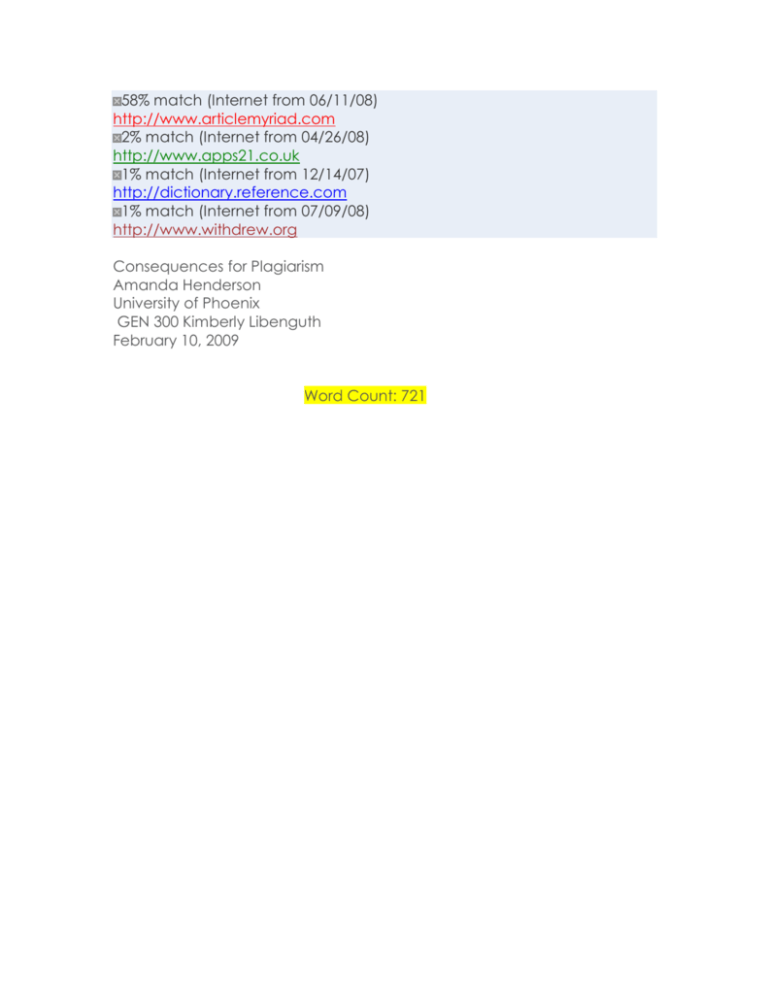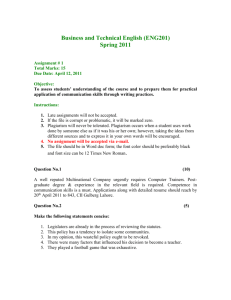58% match (Internet from 06/11/08)
advertisement

58% match (Internet from 06/11/08) http://www.articlemyriad.com 2% match (Internet from 04/26/08) http://www.apps21.co.uk 1% match (Internet from 12/14/07) http://dictionary.reference.com 1% match (Internet from 07/09/08) http://www.withdrew.org Consequences for Plagiarism Amanda Henderson University of Phoenix GEN 300 Kimberly Libenguth February 10, 2009 Word Count: 721 Consequences of Plagiarism Plagiarism is a problem that affects copyright holders in many different environments, however in the academic and college context it means borrowing and writing the ideas of others without giving credit to the source of the material. Saying it another way, plagiarism is a lot like stealing because it is taking someone else’s ideas without giving them due compensation. Plagiarism varies in form (Smith, 2007). One common and blatant method that has come about as a result of the information age is cutting and pasting other people’s work into a new document and calling it one’s own work. Other methods of plagiarism are not as obvious. For example when students paraphrase thoughts or words and use them in their own work without citing and referencing according to a standardized method like APA or MLA, this is plagiarizing. Because it is not always clear what is plagiarism and what is not, it is best to go ahead and cite and reference any material that one suspects, may raise the issue of plagiarism (Smith, 2007). Staying away from any possibility of plagiarism is especially important to students since plagiarism can have dire consequences for a student’s academic career. Plagiarism Policies and Consequences Because colleges and Universities develop their own policies regarding the consequences of plagiarism, the consequences for the act vary widely. Depending on how many times a student has been caught plagiarizing, he or she can have a result of a failing grade on the assignment or in the class or even fail for an entire semester. At the Washington and Lee University, in Lexington, Virginia, consequences of plagiarism are direct and severe. If a student is accused and convicted of plagiarism, he or she is dismissed permanently from the school, effective immediately (Demirjian, 2006). Janet Irons, an aide in the English department at a school in Chicago says that each student is given a copy of the school’s plagiarism policies at the beginning of the school year. Irons states,” If they plagiarize a whole paper, they get an F for the semester. If it's just a major portion, they get an F for the quarter” (Demirijan, 2006). Some incidents of plagiarism result in academic probation or suspension, for a given period of time in addition to writing an essay on the topic of plagiarism, or even attending a one hour long lecture during the course of school. Expulsion is the ultimate price a student can pay for plagiarism. The problem of plagiarism has risen to such levels that as of 2005 colleges and universities have been calling it an epidemic. According many universities are now taking steps to prevent plagiarism. These methods range from software that catches plagiarized content to websites that attempt to educate both students and professors on how to recognize and prevent plagiarism (Warger, 2005). Plagiarism in the Classroom Plagiarism in the classroom is a common form of academic misconduct in which a student represents ideas or wording as their own without proper attribution to the source in which they “borrowed” the information. Plagiarism can be as little as using a sentence or short paragraph from an article and not giving attribution. In 2005 almost 40 percent of college students, according to the Center for Academic Integrity (CAI) research admitted to engaging in some of form of plagiarism, compared to about 10 percent in 1999. According the CAI survey about 77 percent did not see that a use of a sentence or two as a major ethical lapse (Gallant & Drinan, 2006). Students may not consider that their ideas or information as valid or important and may feel that they cannot site their own knowledge and may rely on only what the experts think. There are several reasons that students plagiarize. They may think it is an easy way for a good grade, they may be afraid of putting their own work out for interpretation or review and they may just be lazy (Hutton, 2006). Conclusion Ultimately all sources on plagiarism agree that plagiarism is an unethical act that breaks copyright laws. While there are no certain cures for the ill of plagiarism most sources suggest that better relationships between instructors and students, and informing students of the dangers of plagiarism will go a long way toward turning the tide of the plagiarism epidemic. References Demirjian, K. (2006, May 11). What is the price of plagiarism; When someone steals another’s words, the penalties can vary. The Christian Science Monitor, 98(116, 14-16. Retrieved February 10, 2009 from MasterFILE Premier database Gallant, B., & Drinan, P. (2006, September/October). Organization theory and student cheating: Explanation, responses, and strategies. Journal of Higher Education, 77 (5), 839-860. Retrieved February 10, 2009 from MasterFILE Premier database Hutton, P. A.(2006, Winter). Understanding cheating and what educators can do about it. College Teaching, 54(1), 171-176. Retrieved February 10, 2009 from MasterFILE Premier database Smith, N. (2007). Plagiarism at the college level and its consequences. Article Myriad. Retrieved February 10, 2009 from http://www.articlemyriad.com/30.htm Warger, T. (2005, October). Catching copycats. University Business, 8(10), 33-34. Retrieved February 10, 2009 from MasterFILE Premier database





